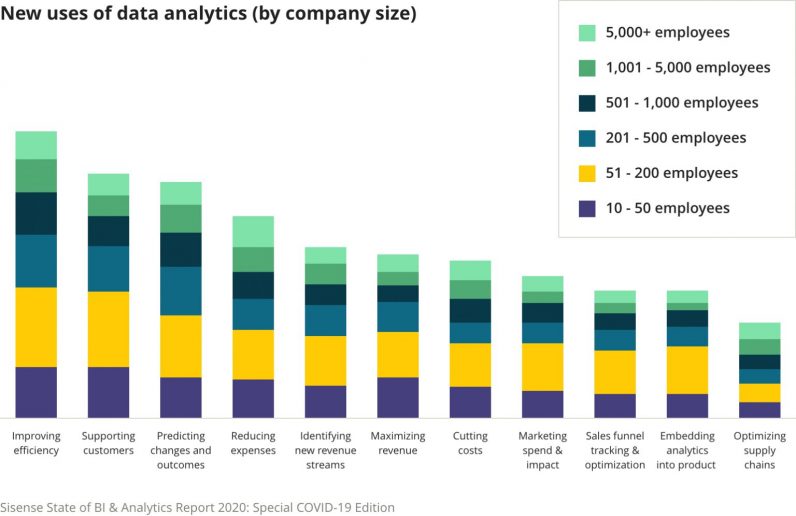When it comes to understanding your customers’ needs and communicating how you can address those needs, you’re going to have to rely on data. While data may not always seem like a natural match with a creative activity like advertising, there is no denying that when used right, it will make all the difference in helping you achieve your desired marketing results.
1) Personalize your marketing content
One-size-fits-all messaging needs to become a thing of the past — at least, that’s what your customers think. More and more often, customers want to see personalized marketing that is better tailored to their interests and even their previous interactions with your brand. [Read: How Netflix shapes mainstream culture, explained by data] Just how important is personalization? A SmarterHQ survey revealed that 72% of customers would only engage with personalized marketing messaging that catered to their unique interests. A little personalization can go a long way — think of how adding a customer’s name to an email can increase open rates. But using your data to make things even more personal will make your advertising even more effective. Research from the Harvard Business Review found that when audiences were given recommendations based on previous clicks on a website, spending on the recommended items increased by 38%. Using data to track customer interactions with your brand can also help you identify where they are in the sales funnel. Analytics programs can help you recognize which actions indicate a customer is more ready to make a purchase. This in turn can trigger more personalized, targeted marketing that has been adapted to their buyer’s journey. Getting the right messages sent out at the right time and place is what ensures that your witty copy and engaging imagery have a meaningful impact on the person viewing it.
2) Improve results by analyzing copy, images, and more
While data’s potential for increasing personalization will get your messages delivered at the right time and place, it is equally important that you use it to fine-tune the messages themselves. This is undoubtedly part of the reason why a Sisense report found that analytics usage is increasing across marketing firms of all sizes in 2020 — by as much as 41% in marketing companies with 51 to 200 employees. Credit: SisenseThe same research report found that 28% of companies believed that the post-COVID-19 world would create new opportunities for growth, making on-point marketing (backed by analytics) more important than ever. The idea of A/B testing in advertising has long been a big part of determining which messages work and don’t work with your target audience. With big data and more robust analytics tools, however, you can scale this testing like never before. Analyzing even seemingly insignificant changes to your marketing materials can help you make continuous improvements to enhance the effectiveness of your messaging. This is why Facebook made continuous tweaks to ad placement and design over the years — their data revealed which placements would get the best results for advertisers. Everything from your call to action and body copy to images and color selection is worth analyzing. When you discover what best appeals to your target audience, you can guide your creative output for greater impact.
3) Turn your own assumptions upside down
Anyone who has spent any time in marketing (myself included) has found themselves guilty at one time or another of thinking something was true when the reality was completely the opposite. Whether this was thinking you knew the best “voice” to use in your marketing materials or being overly confident in how customers would respond to a new product, a lack of data can make it hard to recognize these errors in thinking until it is too late. If you don’t have good data on your side, you could sometimes repeat the same mistake over and over again. Ultimately, that means missed sales opportunities and less effective marketing. Credit: UnsplashI’ve found that one of the most valuable uses for data in marketing is that it helps me check my assumptions at the door. I may think I’ve hit upon a great line of copy, but that’s the thing — it’s what I think. Sometimes, the sales or engagement data that comes back after you put your messaging out into the world can be the complete opposite of what you expect. Often, that’s a sign that you need to take some element of your creative output back to the drawing board. Or maybe you simply need to adjust your placement. Either way, you’ll never realize something is wrong if you aren’t using data every step of the way. By uncovering your false assumptions and unveiling needed changes, your data will ensure that your marketing dollars are well-spent.
Data can (and should) drive marketing success
You don’t have to become a stats wizard to unlock the power of your marketing data. Analytics tools can aggregate and streamline data results, helping you discover key insights so you can make needed adjustments to your campaigns. Pairing data with marketing isn’t going to make you less creative — instead, it will help you uncap the true potential of your creativity by making your marketing messages more effective than ever before.

